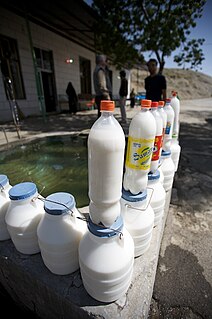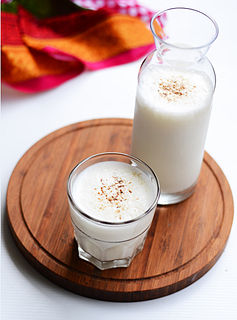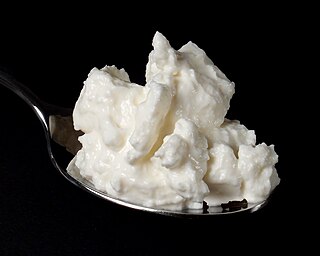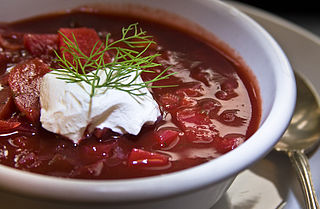 W
WFermented milk products or fermented dairy products, also known as cultured dairy foods, cultured dairy products, or cultured milk products, are dairy foods that have been fermented with lactic acid bacteria such as Lactobacillus, Lactococcus, and Leuconostoc. The fermentation process increases the shelf life of the product while enhancing its taste and improving the digestibility of its milk. There is evidence that fermented milk products have been produced since around 10,000 BC. A range of different Lactobacilli strains has been grown in laboratories allowing for many cultured milk products with different flavors and characteristics.
 W
WAmasi, maas in Afrikaans and mafi in Sesotho, is the common word for fermented milk that tastes like cottage cheese or plain yogurt. It is very popular in South Africa and Lesotho. Amasi is traditionally prepared by storing unpasteurised cow's milk in a calabash container or hide sack to allow it to ferment. The fermenting milk develops a watery substance called umlaza; the remainder is amasi. This thick liquid is mostly poured over the mealie meal porridge called pap, or drunk straight. It is traditionally served in a clay pot and eaten with wooden spoons. Amasi is also produced commercially using Lactococcus lactis subspecies lactis and L. lactis subspecies cremoris.
 W
WCurd is a traditional yogurt or fermented milk product, originating from the Indian subcontinent, usually prepared from cow's milk, and sometimes buffalo milk, or goat milk. It is popular throughout the Indian subcontinent. The word curd is used in English to refer to homemade yogurt, while the term yogurt refers to the pasteurized commercial variety known as heat treated fermented milk.
 W
WButtermilk is a fermented dairy drink. Traditionally, it was the liquid left behind after churning butter out of cultured cream; however, most modern buttermilk is cultured. It is common in warm climates where unrefrigerated fresh milk sours quickly.
 W
WButtermilk koldskål is a sweet cold dairy beverage or dessert eaten in Denmark.
 W
WChaas is a dahi (yogurt)-based drink popular across the Indian subcontinent. It is also written chhaachh. In the Bengal region of the Indian subcontinent, it is called ghol. It is called moru മോര് in Tamil and Malayalam, taak ताक in Marathi, majjiga in Telugu, majjige in Kannada, ale in Tulu. It is often called laban in the Old Dhaka in Bangladesh. In Indian English, it is often referred to as buttermilk.
 W
WClabber is a type of soured milk. It is produced by allowing unpasteurized milk to turn sour (ferment) at a specific humidity and temperature. Over time, the milk thickens or curdles into a yogurt-like substance with a strong, sour flavor.
 W
WCrème fraîche is a dairy product, a soured cream containing 10–45% butterfat, with a pH of approximately 4.5. It is soured with a bacterial culture. European labeling regulations specify the two ingredients must be cream and bacterial culture. It is served over fruit and baked goods, as well as being added to soups and sauces. It is used in a variety of other recipes. Sour cream is a similar foodstuff, except that crème fraîche is less sour and has a higher fat content. Sour cream may contain thickening agents not permitted in crème fraîche in many jurisdictions.
 W
WDoogh is a cold savory yogurt-based beverage that is mixed with salt. It is popular in Central Asia, Eastern Europe, and the Middle East.
 W
WFilmjölk, also known as fil, is a traditional fermented milk product from Sweden, and a common dairy product within the Nordic countries. It is made by fermenting cow's milk with a variety of bacteria from the species Lactococcus lactis and Leuconostoc mesenteroides. The bacteria metabolize lactose, the sugar naturally found in milk, into lactic acid which means people who are lactose intolerant can tolerate it better than other dairy products. The acid gives filmjölk a sour taste and causes proteins in the milk, mainly casein, to coagulate, thus thickening the final product. The bacteria also produce a limited amount of diacetyl, a compound with a buttery flavor, which gives filmjölk its characteristic taste.
 W
WFromage blanc is a fresh cheese originating from the north of France and the south of Belgium. The name means "white cheese" in French. Fromage frais differs from fromage blanc in that, according to French legislation, fromage frais must contain live cultures when sold, whereas with fromage blanc, fermentation has been halted.
 W
WJocoque or jocoqui and jocoque seco is a dairy product based on fermented milk, typical of Mexican cuisine.
 W
WKashk is a range of dairy products used in cuisines of Iranian, Afghan, Turkish, Mongolian, Central Asian, Transcaucasian and the Levantine people. Kashk is made from drained yogurt or drained sour milk by forming it and letting it dry. It can be made in a variety of forms, including rolled into balls, sliced into strips, and formed into chunks.
 W
WKaymak is a creamy dairy product similar to clotted cream, made from the milk of water buffalo, cows, sheep, or goats in Central Asia, some Balkan countries, some Caucasus countries, Turkic regions, Iran and Iraq.
 W
WKefir or kephir, is a fermented milk drink similar to a thin yogurt that is made from kefir grains, a specific type of mesophilic symbiotic culture. The drink originated in the North Caucasus, Eastern Europe and Russia, where it is prepared by inoculating cow, goat, or sheep milk with kefir grains.
 W
WKumis is a fermented dairy product traditionally made from mare's milk or donkey milk. The drink remains important to the peoples of the Central Asian steppes, of Huno-Bulgar, Turkic and Mongol origin: Kazakhs, Bashkirs, Kalmyks, Kyrgyz, Mongols, and Yakuts. Kumis was historically consumed by the Khitan, Jurchen, Hungarians and Han Chinese of North China as well.
 W
WLassi is a popular traditional dahi (yogurt)-based drink that originated in the Indian Subcontinent. Lassi is a blend of yoghurt, water, spices and sometimes fruit. Namkeen (salty) lassi is similar to doogh, while sweet and mango lassis are like milkshakes. Bhang lassi is infused with cannabis in the form of bhang. Chaas is a similar drink of a thinner consistency.
 W
WThe term leben, variously laban, lben in the Arab World, refers to a food or beverage of fermented milk. Generally, there are two main products known as leben: in the Levant region and parts of Arabia, yogurt; and in Arabia and North Africa (Maghreb), buttermilk. Leben can be served at breakfast, lunch or dinner.
 W
WMatzoon or matsoni is a fermented milk product of Armenian origin, distributed in Armenia and Georgia. In Japan, it is called Caspian Sea yogurt.
 W
WMursik is a traditional fermented milk variant of the Kalenjin people of Kenya. It can be made from cow or goat milk and is fermented in a specially made calabash gourd locally known as a sotet. The gourd is lined with soot from specific trees which add flavor to the fermented milk. It is normally consumed with ugali or on its own and is served at room temperature or chilled.
 W
WPomazánkové máslo is a traditional Czech and Slovak dairy product. It is a spread made from sour cream, milk powder and buttermilk powder. It also contains starch, salt and usually herb or similar flavoring. The Czech food regulator requires the pomazánkové máslo must consist of at least 31% milk fat and 42% milk solids. Milk fat cannot be replaced by vegetable fat.
 W
WQuark or quarg is a type of fresh dairy product made by warming soured milk until the desired amount of curdling is met, and then straining it. It can be classified as fresh acid-set cheese. Traditional quark can be made without rennet, but in modern dairies small quantities of rennet are typically added. It is soft, white and unaged, and usually has no salt added. It is traditional in the cuisines of German-speaking, Dutch-speaking, Slavic and Scandinavian countries.
 W
WRyazhenka or ryazhanka is a traditional fermented milk product in Belarus, Russia and Ukraine. It is made from baked milk by lactic acid fermentation.
 W
WSkyr is an Icelandic cultured dairy product. It has the consistency of Greek yoghurt, but a milder flavour. Skyr can be classified as a fresh sour milk cheese but is consumed like a yoghurt. It has been a part of Icelandic cuisine for centuries.
 W
WSmetana is a type of sour cream from Central and Eastern Europe. It is a dairy product produced by souring heavy cream. It is similar to crème fraîche, but nowadays mainly sold with 9% to 36% milkfat content depending on the country. Its cooking properties are different from crème fraîche and the lighter sour creams sold in the US, which contain 12 to 16% butterfat. It is widely used in cooking and baking.
 W
WSour cream or soured cream is a dairy product obtained by fermenting regular cream with certain kinds of lactic acid bacteria. The bacterial culture, which is introduced either deliberately or naturally, sours and thickens the cream. Its name comes from the production of lactic acid by bacterial fermentation, which is called souring. Crème fraîche is one type of sour cream with a high fat content and less sour taste.
 W
WSoured milk denotes a range of food products produced by the acidification of milk. Acidification, which gives the milk a tart taste, is achieved either through bacterial fermentation or through the addition of an acid, such as lemon juice or vinegar. The acid causes milk to coagulate and thicken, inhibiting the growth of harmful bacteria and improving the product's shelf life.
 W
WStrained yogurt, Greek yogurt, yogurt cheese, sack yogurt, or kerned yogurt is yogurt that has been strained to remove most of its whey, resulting in a thicker consistency than regular unstrained yogurt, while still preserving the distinctive sour taste of yogurt. Like many types of yogurt, strained yogurt is often made from milk that has been enriched by boiling off some of its water content, or by adding extra butterfat and powdered milk. In Europe and North America, it is often made from low-fat or fat-free cow's milk. In Iceland, a similar product named skyr is made.
 W
WTzatziki, cacık or tarator is a dip, soup, or sauce found in the cuisines of Southeast Europe and the Middle East. It is made of salted strained yogurt or diluted yogurt mixed with cucumbers, garlic, salt, olive oil, sometimes with vinegar or lemon juice, and herbs such as dill, mint, parsley and thyme. It is generally served as a cold appetizer (meze) or a side dish.
 W
WVarenets, sometimes anglicised as stewler or simmeler, is a fermented milk product that is popular in Russia. Similar to ryazhenka, it is made by adding sour cream (smetana) to baked milk.
 W
WViili (Finnish) is a mesophilic fermented milk product found in Finland. This cultured milk snack resembles yoghurt and is the result of microbial action of lactic acid bacteria (LAB) and a surface-growing yeast-like fungus Geotrichum candidum present in milk, which forms a velvet-like surface on viili. In addition, most traditional viili cultures also contain yeast strains such as Kluveromyces marxianus and Pichia fermentans. The lactic acid bacteria identified in viili include the acid‐producing Lactococcus lactis subsp. lactis and L. l. cremoris as well as the aroma producers L. lactis subsp. lactis biovar diacetylactis and Leuconostoc mesenteroides. Among those mesophilic LAB strains, the slime-forming Lc. lactis subsp. cremoris produce a phosphate-containing heteropolysaccharide, named viilian. Viilian is similar to kefiran produced by kefir grains. The production of exopolysaccharides (EPS) by the strain forms the consistency character of viili and it has been claimed to have various functional benefits toward the rheological properties of milk products and the health improving potential.
 W
WYakult is a Japanese sweetened probiotic milk beverage fermented with the bacteria strain Lactobacillus paracasei Shirota. It is sold by Yakult Honsha, based in Tokyo. It is distributed through convenience stores and supermarkets, in single-serving containers of 65 millilitres or 100 millilitres, often in single-row packs of five or seven.
 W
WYayık ayranı, also known as Turkish buttermilk, is a traditional Turkish drink produced from fermented buttermaking by-products, water and salt. It has been traditionally prepared in barrel churns or skin bags. Despite the similar name, it is distinct from ayran. Goat, sheep, or cow's milk can be used for Turkish buttermilk production. Certain acid curd cheeses such as çökelek could also be obtained from yayık ayranı when heated.
 W
WYmer is a Danish soured milk product which has been known since 1930. It is made by fermenting whole milk with the bacterial culture Lactococcus lactis. When producing fermented milk products such as yogurt, ymer, filmjölk, skyr, qvark and A-38, and also when producing cheese, one can add lactic acid bacteria which convert milk sugar in the milk into lactic acid and other substances. Acidity makes the milk thicker, gives it a tart flavor, and increases the shelf life by several days.
 W
WYogurt, also spelled yoghurt, yogourt or yoghourt, is a food produced by bacterial fermentation of milk. The bacteria used to make yogurt are known as yogurt cultures. Fermentation of sugars in the milk by these bacteria produces lactic acid, which acts on milk protein to give yogurt its texture and characteristic tart flavor. Cow's milk is commonly available worldwide and, as such, is the milk most commonly used to make yogurt. Milk from water buffalo, goats, ewes, mares, camels, yaks and plant milks are also used to produce yogurt. The milk used may be homogenized or not. It may be pasteurized or raw. Each type of milk produces substantially different results.